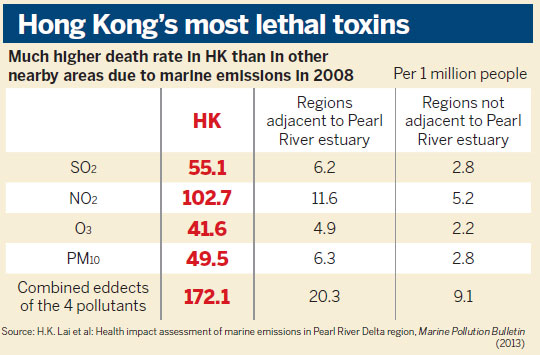Hoping for a breath of fresh air
Updated: 2015-04-16 07:59
By Andrea Deng(HK Edition)
|
|||||||||
HK's new benchmark of 0.5% sulfur content in marine emissions is still five times higher than international standard. Andrea Deng reports.
Hong Kong has taken what it considers a major step forward in reducing deadly sulfur dioxide (SO2) emissions. Yet the new benchmark of 0.5 percent sulfur content in ships' emissions is five times higher than the international benchmark of 0.1 percent as in 2015.
Sulfur dioxide is among the deadliest pollutants in Hong Kong's air, and is believed to be responsible for up to 400 premature deaths every year, according to a 2013 study compiled by Civic Exchange, a local public policy think tank, and the Hong Kong University of Science and Technology.
Exhaust fumes from navigation are the greatest culprit, contributing half of Hong Kong's SO2 pollution, according to the Environmental Protection Department.
The Air Pollution Control (Ocean Going Vessels) (Fuel at Berth) Regulation will take effect on July 1 this year. The SAR government estimates that the reduction to 0.5 percent emissions by ships at berth will result in a 12 percent reduction in the city's SO2 pollution. Under present regulations ocean-going vessels berthing in Hong Kong spew exhaust fumes containing 2.6 percent SO2 emissions on average.
As of January 1 this year, the United States, Canada and most of Europe had established regulations in accordance with the new benchmark set by the International Convention for the Prevention of Marine Pollution for Ships (MARPOL) Convention, i.e., 0.1 percent. Thus, Hong Kong, as an associate member of MARPOL and the first city in Asia to control ships' emissions, remains out of step with much of the industrialized world.
According to Lai Hak-kan, professor at School of Public Health, University of Hong Kong (HKU), excess of SO2 in the air could lead to a whole list of cardiovascular diseases, including heart attacks, arrhythmia, heart valve decay, ischemic stroke and others. It could also exacerbate chronic obstructive pulmonary disease and chronic bronchitis. Prolonged exposure to SO2 could cause inflammation of the lungs which might lead to emphysema. Some victims experience cerebrovascular disease, which could lead to stroke, from deterioration of the blood vessels supplying the brain.
The new regulation on SO2 emissions aims to reduce the annual death toll, directly attributable to emissions of the stinking, poisonous gas that also contributes to the city's air pollution and could cause smog and acid rain.
Wong Kwai-ting, chairman of the Hong Kong International Terminals Group Employees General Union, said the new regulation - while it could be improved upon - will be a relief to some 2,000 dockworkers on the city's waterfront: "Sometimes dockworkers feel dizzy, or they have a running nose from breathing vessel exhaust fumes."
The foul smell is very likely caused by SO2, owing to its relatively high water solubility, according to Dr Wong Tze-wai, co-director of the Centre for Occupational & Environmental Health Studies at the Chinese University of Hong Kong (CUHK). SO2 is invisible, but it exudes a putrid stench, which merely adds to the discomfort of workers who cough, get dizzy, struggle to breathe, he said.
PRD's most-polluted
In the Pearl River Delta region, Hong Kong suffers the biggest mortality owing to SO2 pollution. Lai Hak-kan from HKU's School of Public Health found in 2013 that for every 1 million people in Hong Kong, there were 55.1 deaths attributable to SO2 emission from ocean and river vessels in 2008. In comparison, only 6.2 out of 1 million living adjacent to the Pearl River Delta estuary, and 2.8 out of 1 million living not adjacent to it, died of SO2 poisoning in the same year.
"A lot of vessels heading to Yantian or Shekou in Shenzhen have to pass through Hong Kong - one main reason that health impact of ships' emission is highest on Hong Kong," said Simon Ng Ka-wing, chief research officer with Civic Exchange.
The Labour Department, however, declared that it was "not necessary" to establish a sulfur content index to evaluate the working environment on the Hong Kong waterfront. The department has decided that the main pollutant from vessel emissions is nitrogen dioxide (NO2), and that the levels of nitrogen dioxide are "comparable" to those of SO2.
The Labour Department's argument, says Dr Wong, the occupational health expert from CUHK, is flawed and unscientific. Wong explains that while it is true that the concentration of nitrogen dioxide at the docks is the highest in terms of raw numbers, when compared with other pollutants, the World Health Organization (WHO) sets a much more stringent limit on acceptable levels of SO2 (a daily average of 20 g/m3 - microgram per cubic meter) than NO2 (a daily average of 140 g/m3).
The highest one-day concentration level of SO2 in Kwai Chung in the past year was 105.05 g/m3, more than five times the WHO standard. While the highest one-day concentration level of NO2 in Kwai Chung was 174.23 g/m3, less than twice the WHO standard.
The annual average SO2 concentration in Kwai Chung hit 20 microgram per cubic meter (g/m3), whereas Mong Kok's annual SO2 concentration level is 14 g/m3 - as shown in the Hedley Environmental Index.
Contact the writer at andrea@chinadailyhk.com

(HK Edition 04/16/2015 page8)